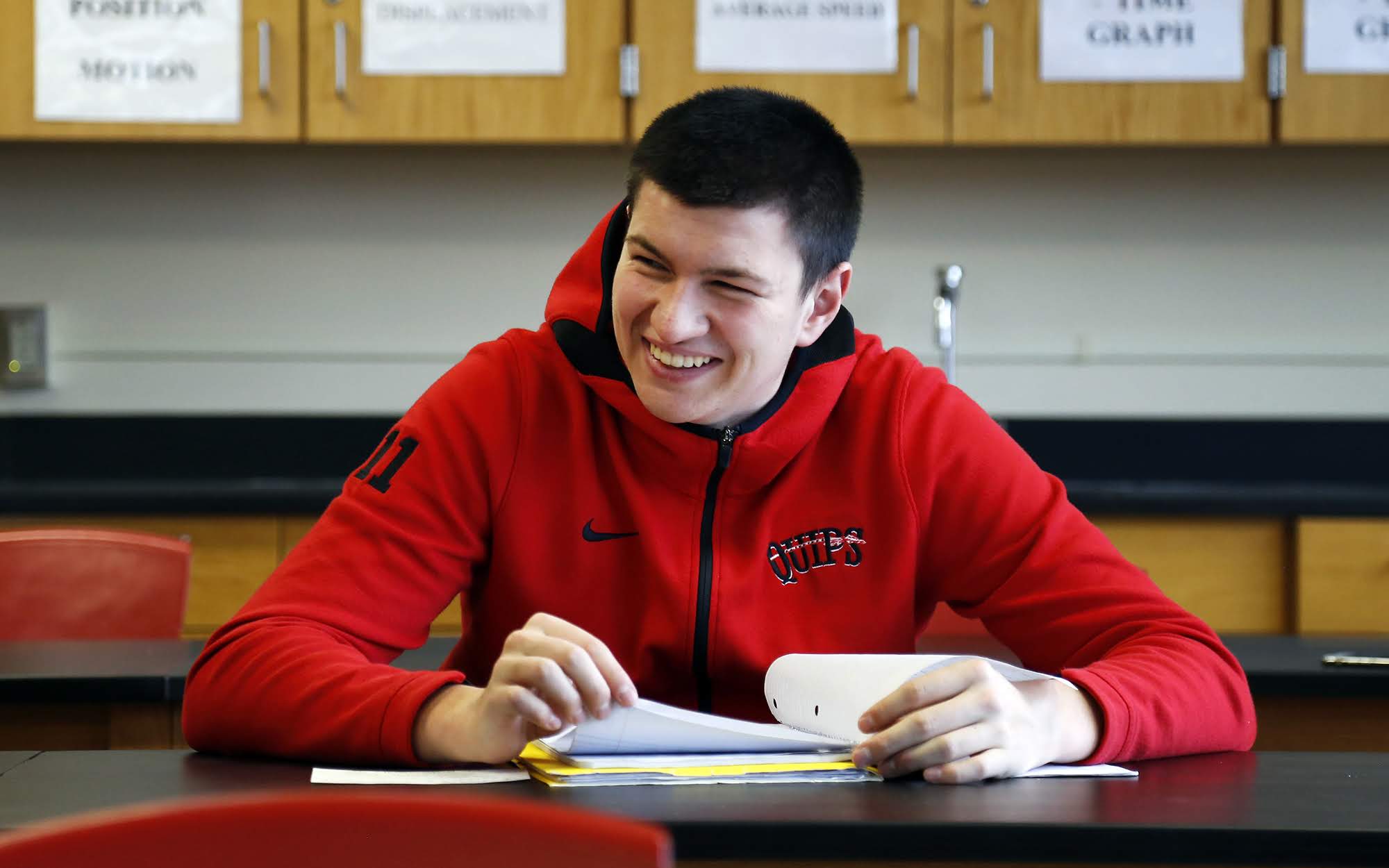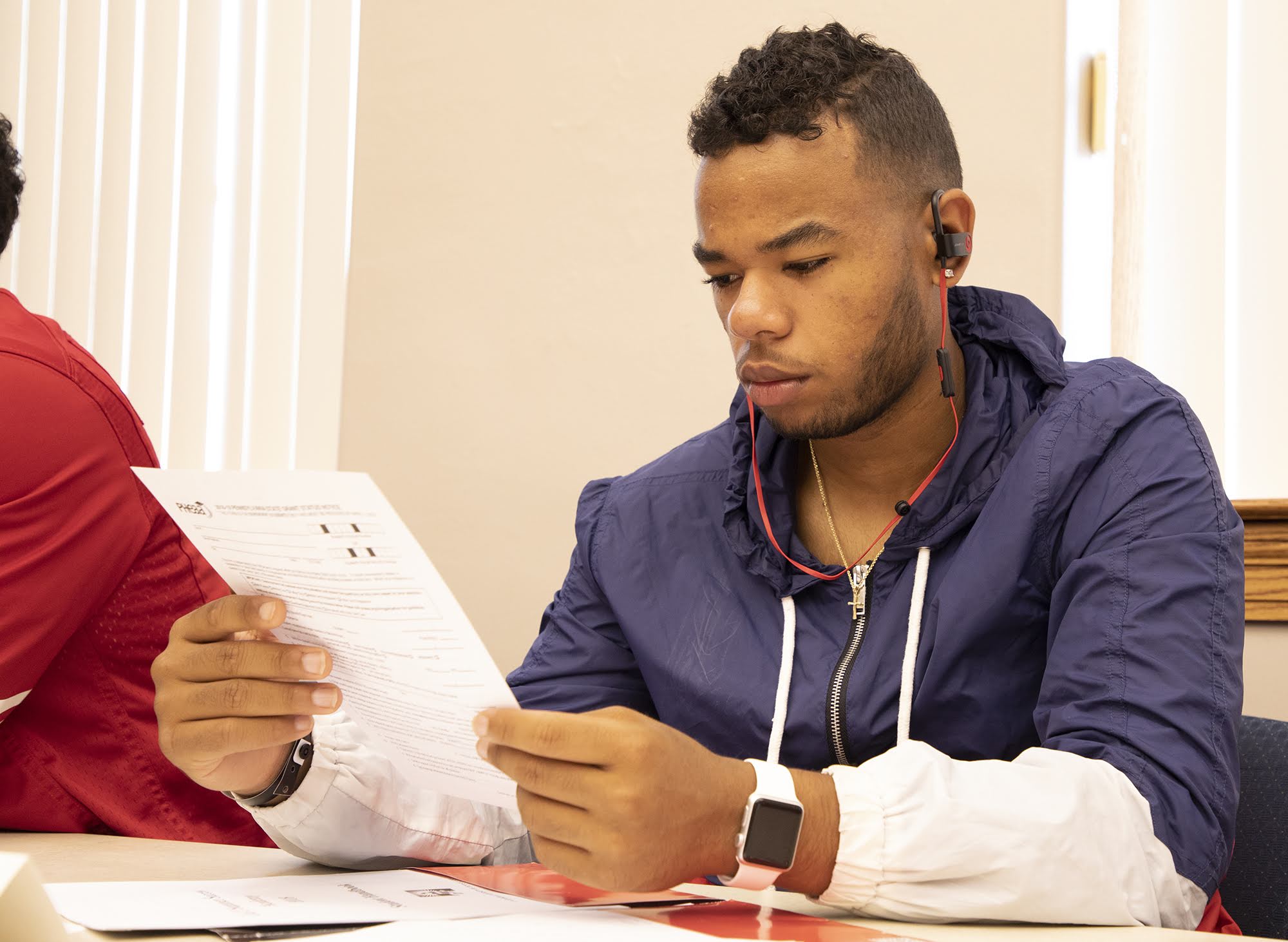Part of the PublicSource series
Failing the Future
Eli Kosanovich, a senior at Aliquippa Junior/Senior High School and star quarterback for the Quips football team, pushes boundaries. On the field and in the classroom. On the gridiron this fall, Eli led his team to the state championship. Along the way, he passed for a school record of more than 3,000 yards and completed 39 touchdowns. In the classroom, he has earned a 4.3 GPA.
This story isn’t the typical story of a student who just happens to be athletic and book smart, but rather a story of how an uncommon arrangement has allowed a student to achieve both in unlikely circumstances.
Eli’s football achievements fall within the Aliquippa School District.
But his academic successes are shared with the Hopewell Area School District, where Eli has been able to take Advanced Placement and honors courses that aren’t available at Aliquippa Junior/Senior High School.
“It was a great opportunity for me to do that…” Eli said. “The teachers, they are great, too, up there. They welcomed me like I was one of their own.”
The arrangement between Hopewell and Aliquippa is one example of sharing among school districts of varying wealth. The Aliquippa district is on the state’s financial watch list. The sharing of resources between the two districts is a remnant of a countywide cooperative agreement that started in 2007 with a now-expired federal grant.
In an era when education funding is limited and the gap between well-resourced districts and their less fortunate neighbors widens, sharing emerges as one of the few options for opening up high-quality academic and extracurricular programs to all students.
The idea is not widely embraced by districts. But it is lauded by state Secretary of Education Pedro Rivera.
“We live in a time when some students have access to a robust portfolio of learning opportunities and experiences and life experiences and others still do not,” Rivera told PublicSource in a July interview.
In the past year, PublicSource has explored the disparities that exist between school districts in Southwestern Pennsylvania — disparities largely attributed to an education funding system that relies heavily on local real estate taxes.
“We live in a time when some students have access to a robust portfolio of learning opportunities and experiences and life experiences and others still do not.”
Two districts (featured in earlier stories) — Sto-Rox and Clairton — sit next to the wealthier districts of Montour and West Jefferson Hills, respectively. But, unlike Hopewell and Aliquippa, there is little-to-no sharing of resources between the districts.
A permanent solution to the problem of disparate education funding statewide could come from a lawsuit pending in Commonwealth Court that argues education funding in Pennsylvania is inadequate and inequitable.
But arguments in that case are not scheduled until the summer of 2020 and even if the court rules against the current system, changes to education funding could be years in the making. The Legislature would be tasked with identifying a new revenue source to provide the additional $3 to $4 billion needed to fully fund education.
Sharing resources
In the meantime, as education officials look to find more immediate ways to help narrow the divide between the haves and have-nots, sharing resources emerges as a logical solution. And it stops short of suggesting mergers, which appear to be widely opposed.
“I think [sharing] is a partial solution to what is obviously a very large issue,” said Jacie Maslyk, Hopewell’s assistant superintendent.
She said her district welcomes Aliquippa students into honors and AP courses and to participate on some sports teams that aren’t offered at their school. Hopewell also allows the Aliquippa track team to use its track for practices because there is no track at Aliquippa.
“We generally just sign an agreement that the [Aliquippa] students can participate. Basically if it’s something that they don’t offer and we do, what’s another kid in the class or another kid on the team? Especially [because] they are literally right down the street,” Maslyk said.
In Hopewell, about 33 percent of the students are economically disadvantaged as compared with nearly 100 percent in Aliquippa.
Rivera said state law does not give him or his department the authority to force districts to share or merge. But, he said, the department highlights and praises districts that share resources and, when possible, provides financial incentives and rewards.
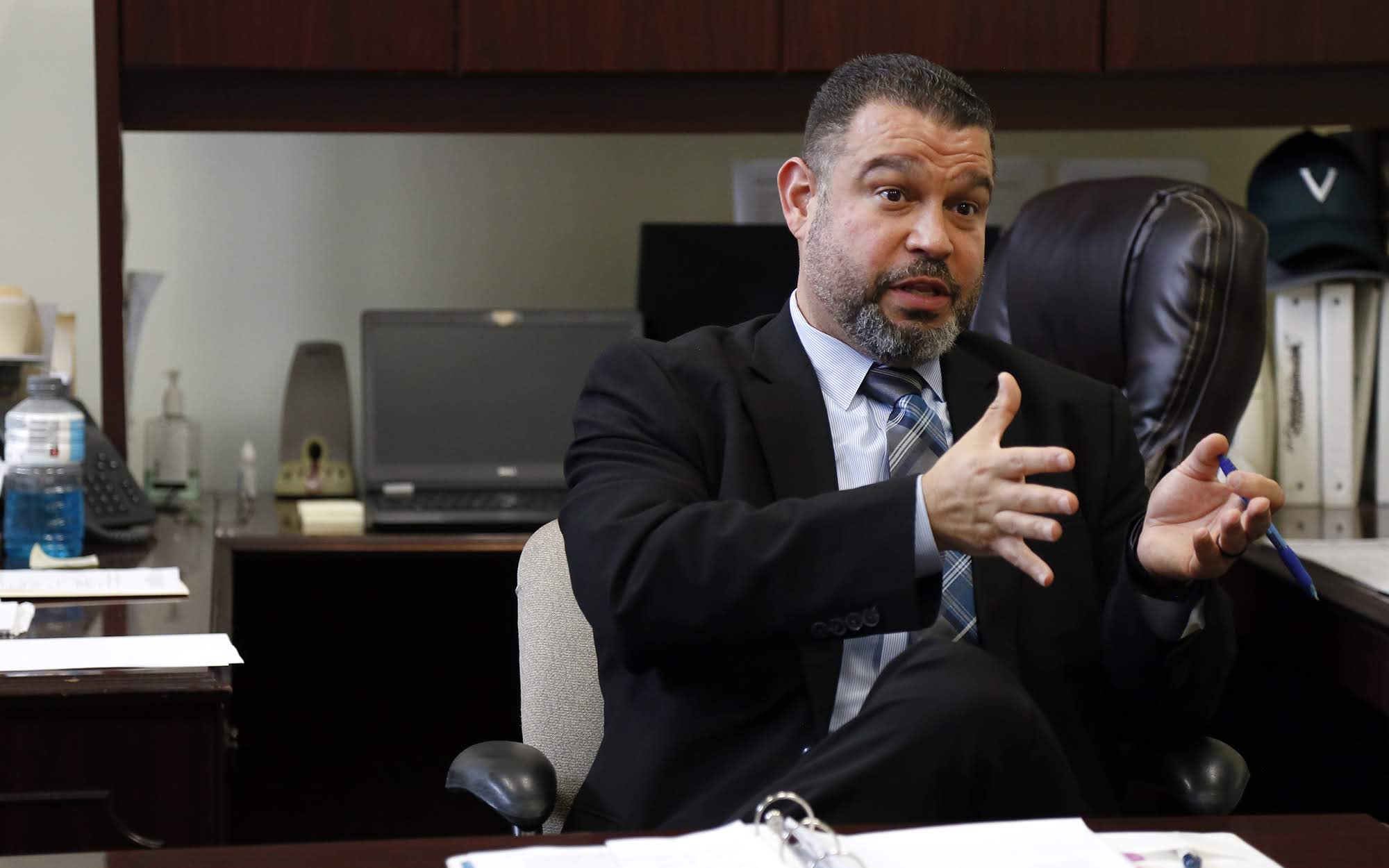
Pennsylvania Secretary of Education Pedro Rivera visits Sto-Rox Junior-Senior High School on Sept. 24, 2018, to discuss funding issues with Superintendent Frank Dalmas and others. (Photo by Ryan Loew/PublicSource).
For example, the department provided an additional $3 million to the Wilkinsburg School District to help with the transition of its secondary students to Pittsburgh Public Schools in 2016. The two districts reached an agreement for Wilkinsburg students in grades 7-12 to attend Pittsburgh schools on a tuition basis.
Currently, 245 Wilkinsburg secondary students attend Pittsburgh schools. The students are assigned to Pittsburgh Westinghouse 6-12, but can also apply to magnet schools within the Pittsburgh district. Of the total, 201 attend Westinghouse, while others are enrolled at other Pittsburgh secondary schools.
Wilkinsburg students also qualify for college, trade or technical school tuition funds from the Pittsburgh Promise.
The move came after the Wilkinsburg school board decided the district lacked sufficient funding and enrollment to continue to offer an adequate middle or high school program.
The partnership with Pittsburgh came after Wilkinsburg’s efforts to partner with adjacent suburban districts of Penn Hills and Woodland Hills were rebuffed.
The state Legislature brokered a similar agreement in 2007 to allow high school students in Duquesne to attend West Mifflin and East Allegheny districts on a tuition basis. The Legislature and then-state Education Secretary Gerald Zahorchak got involved when a voluntary agreement could not be reached.
Several years later, middle school students were included in the arrangement. Currently, 23 Duquesne students in grades 7-12 are assigned to East Allegheny schools and 295 are assigned to the West Mifflin district.
Rivera supports partnerships like those between Wilkinsburg and Pittsburgh and Duquesne and its neighboring districts. He also praised the relationship between Aliquippa and Hopewell — one that has allowed Eli to take AP biology, AP calculus and honors U.S. history.
“I would like to see all school districts do this,” Rivera said.
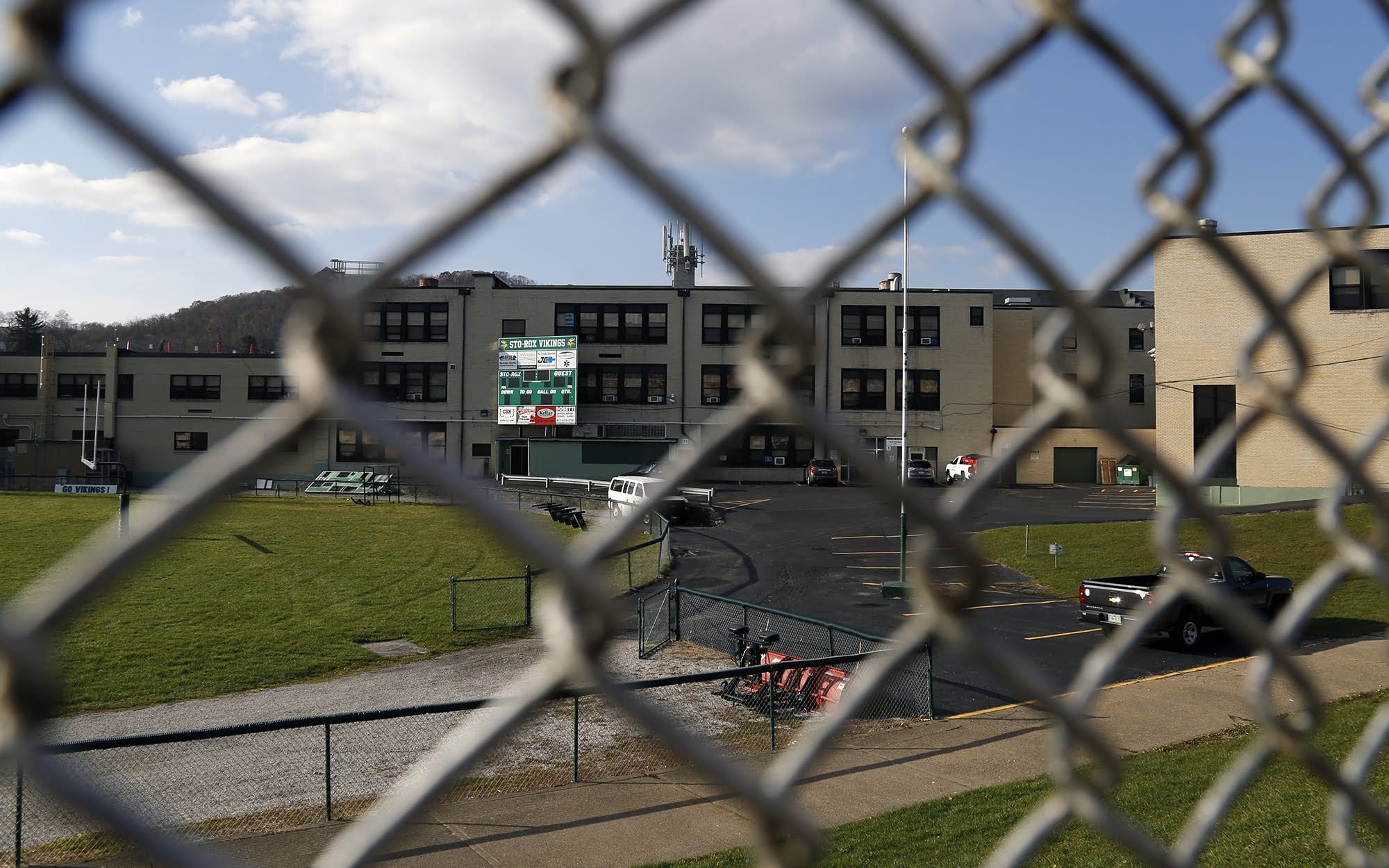
Sto-Rox Junior-Senior High School. (Photo by Ryan Loew/PublicSource)
Without Hopewell’s high-level courses, it would have been difficult for Eli to attain his 4.3 GPA. He’s using that academic record, along with his athletic skills to negotiate possible college scholarships with some Division III colleges. He hopes to major in engineering or pre-med.
Aliquippa students first started to attend classes at Hopewell High School as part of the Regional Choice Initiative in 2007. The Beaver Valley Intermediate Unit [BVIU] organized the initiative, and it was funded through a $5 million Voluntary Public School Choice Grant from the U.S. Department of Education.
The initiative allowed students in the school districts of Beaver County and Ellwood City Area, which spans Beaver and Lawrence counties, to enroll in classes in neighboring districts if they weren’t offered in their home districts.
The grant money was also available for students to take courses at Community College of Beaver County and Penn State Beaver and for districts to use teleconferencing to offer new classes, such as Mandarin Chinese, to students.
“It was about how can we work collaboratively, collectively and fiscally responsibly to help students achieve at that higher level,” said Eric Rosendale, BVIU executive director.
Funding for the initiative ran out in 2013, but some districts continue to share resources, Rosendale said. The Western Beaver and Blackhawk school districts share a superintendent. The New Brighton, Rochester and Beaver Falls school districts share a technology director.
Mergers
In 2009, Beaver County became the site of what state education officials have called the only voluntary school merger in Pennsylvania.
Conversely, it’s also the home of the Midland School District, which had to bus its students to East Liverpool, Ohio, in the 1990s after it closed its high school, other districts in the county refused its merger requests and a district that initially accepted students reneged on the agreement. Currently, Midland high school students attend either Beaver Area High School or charter schools, including PA Cyber Charter School and the Lincoln Park Performing Arts Charter School, both located in Midland.
The voluntary merger occurred in 2009 when the Center Area and Monaca school districts joined after several years of sometimes rocky negotiations and planning.
Their merger reduced the number of school districts in the state from 501 to 500. It was the first consolidation since the 1960s and 1970s when the state issued a directive to reduce the number of school districts from 2,189 to about 500.
(The Woodland Hills School District was formed by a 1981 federal court order aimed at achieving racial desegregation. The court mandated the merger of the General Braddock district with the school districts of Churchill, Edgewood, Swissvale and Turtle Creek.)
At the time of the merger of the Center Area and Monaca districts into the Central Valley School District, state officials said they hoped it would serve as an example to other districts to follow. But that hasn’t happened.
In Pennsylvania, 17 districts in addition to Center and Monaca expressed interest in merging since 2000. But none found willing partners, according to a national report about mergers released in July from the nonprofit EdBuild.
Among them was Clairton, which wrote to four neighboring districts in 2011 seeking a merger but was turned down by all.
“But … it’s really not a solution because we are probably not receiving all of the funding that we deserve from the state and neither are they, so combining districts and not solving the problem at the state level is not solving anything.”
West Jefferson Hills Superintendent Michael Ghilani said he was unaware of the merger request in 2011. Regardless, he is not supportive of mergers. “You have to consider culture and you have to consider climate and the impacts of that and it might be what many people see as an easy solution,” he said during a March interview.
“But … it’s really not a solution because we are probably not receiving all of the funding that we deserve from the state and neither are they, so combining districts and not solving the problem at the state level is not solving anything.”
Ron Cowell, president of the Education Policy and Leadership Center and a former state legislator, said it doesn’t make sense to have 500 school districts in Pennsylvania, 43 of which are in Allegheny County.
The high number of districts “puts pockets of wealth next to pockets of poverty… Kids are dependent on whether they live on this side of the street or that side of the street,” said Cowell, a former chair of the House Education Committee.
Still, he said, legislators don’t advocate for school mergers because their constituents don’t want them.
“There is a saying that the hardest animal to kill is a school mascot,” Cowell said.
“Legislators consider it cutting their political wrists to consider forming mergers.”
Cowell said mergers are difficult because they can require one district absorbing another district’s debt and legal obligations such as teachers’ contracts.
Strong leadership needed for change
Given the resistance to mergers, sharing services and academic opportunities could be an easier prospect for school districts, said Linda Hippert, former superintendent of the South Fayette Township School district and retired executive director of the Allegheny Intermediate Unit.
But, she said, it is sometimes difficult for superintendents to promote sharing if their school boards aren’t supportive of the idea. “Because they answer to their board who is elected by the community. There has to be a belief system in the community that we need to work together to provide equity for all students.”
She said increasing the sharing between districts will “take strong leadership with a strong vision.” That means a superintendent and a board who are on the same page about helping students from other communities.
“It’s easy to say to say, ‘We will take care of our kids.’ But who are our kids? Our kids aren’t just the community in which we live. We should all be thinking that our kids are all of our kids in this region,” said Hippert, now an assistant professor of education at Point Park University.
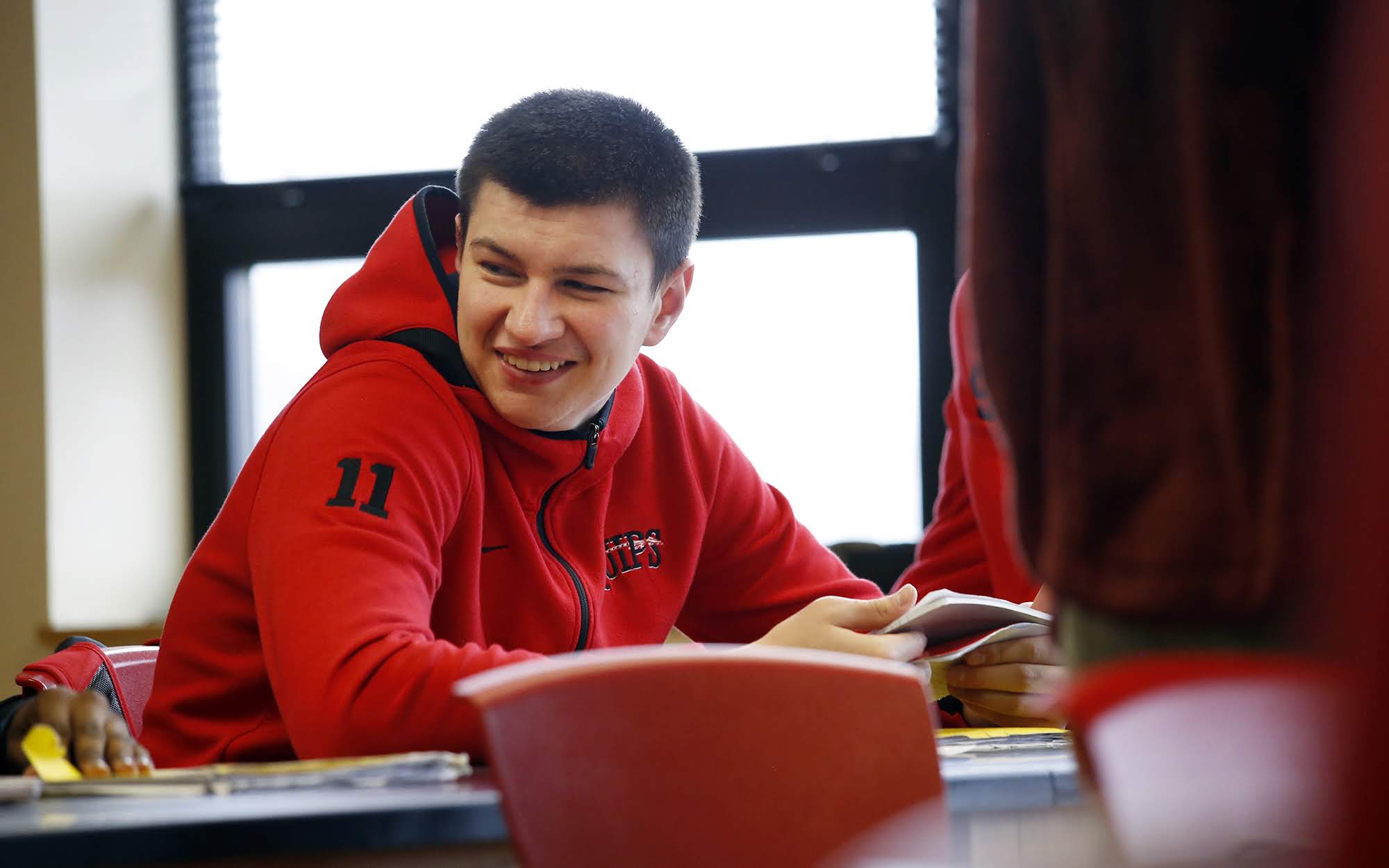
Eli Kosanovich, a senior at Aliquippa Junior/Senior High School, takes some honors and Advanced Placement classes at neighboring Hopewell School District. (Photo by Ryan Loew/PublicSource)
In addition to sharing academic opportunities, Hippert suggested that large districts could provide administrative services for smaller districts, with each community keeping its own schools.
“The idea is to free up money for academics,” she said.
Following his team’s victory at the state football championship on Dec. 8., Eli is hoping to field scholarship offers based on his impressive athletic and academic records. He knows he has more options because of his high GPA made possible by access to the classes at Hopewell.
Eli said he doesn’t understand why more well-resourced school systems don’t share with their less wealthy neighbors. He posed a question to them: “If the tables were flipped, how would you want to be treated?”
This story was fact-checked by Jeff Benzing.
Mary Niederberger covers education for PublicSource. She can be reached at 412-515-0064 or mary@publicsource.org.
Stephanie Hacke contributed reporting to this story.
This project has been made possible with the generous support of The Grable Foundation and the Education Writers Association.
